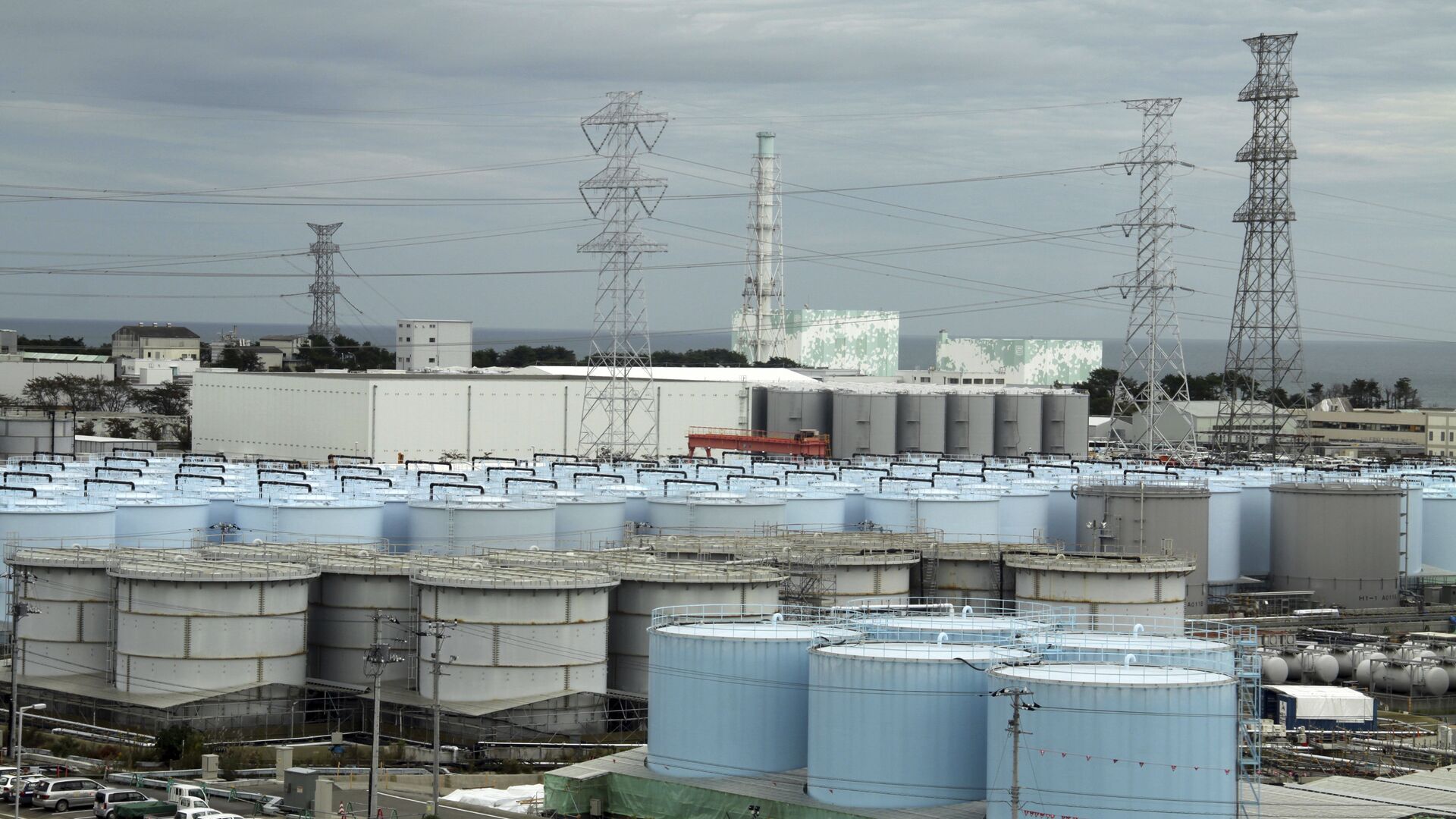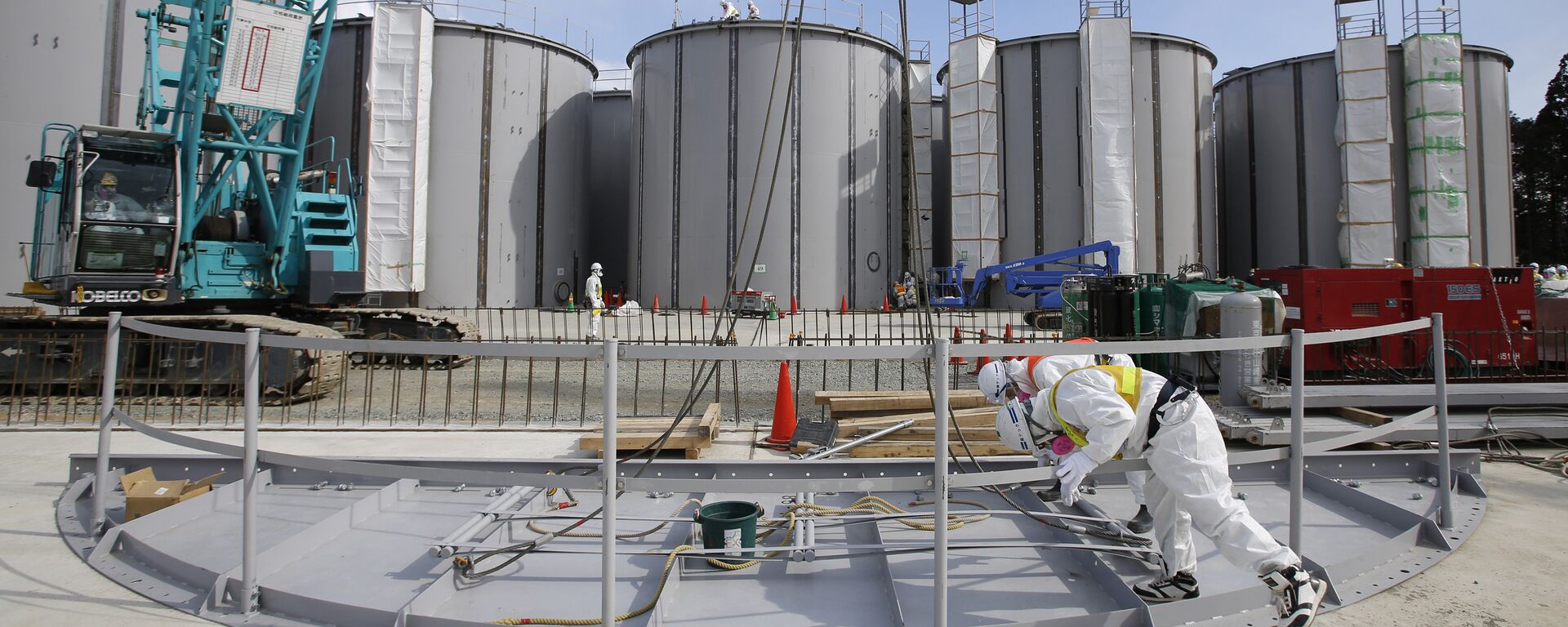https://sputnikglobe.com/20230705/iaea-boss-tours-fukushima-ahead-of-impending-ocean-release-of-contaminated-water-1111672426.html
Japanese and Neighbors Brace for Radioactive Fukushima Water Release Into Ocean
Japanese and Neighbors Brace for Radioactive Fukushima Water Release Into Ocean
Sputnik International
The International Atomic Energy Agency (IAEA) has attempted to assuage public concerns about the impending discharge of treated water from the Fukushima Daiichi Nuclear Power Plant in Japan.
2023-07-05T13:08+0000
2023-07-05T13:08+0000
2023-07-31T17:00+0000
world
japan
international atomic energy agency (iaea)
tokyo electric power company (tepco)
fukushima daiichi nuclear power plant
radiation
water
fukushima
https://cdn1.img.sputnikglobe.com/img/106091/77/1060917747_0:156:3001:1844_1920x0_80_0_0_d0ef4c01be8914cb18618a35ccfbe04f.jpg
International Atomic Energy Agency (IAEA) chief Rafael Grossi met with residents of the Fukushima Prefecture where the crippled nuclear plant is located this week in preparation for the discharge of the contaminated water into the ocean.In the years that followed the Fukushima nuclear disaster, some 1.33 million cubic meters of contaminated water ended up being accumulated at the plant: water that was used to cool the damaged reactors, as well as rainwater and groundwater that seeped into the site.Now, as the site is running out of storage space, Fukushima Daiichi’s operator Tokyo Electric Power Company (TEPCO) plans to release this water into the ocean after subjecting the contaminated liquid to a treatment by ALPS processing system meant to remove the majority of radioactive elements.The discharge, which is expected to take place over the course of decades, has been approved by the IAEA, even though Grossi did admit that some concerns remain.The water discharge plan has encountered opposition from people in Japan and in the neighboring countries such as China and South Korea.Chinese National Nuclear Safety Administration also criticized the IAEA report, which endorses the plan to release radioactive water into the ocean, insisting that it "fails to fully reflect the opinions of experts from all parties involved in the assessment, and the conclusions are not unanimously recognized by all experts."Earlier, a spokesman for China’s Ministry of Foreign Affairs said Beijing thinks that the IAEA report, which essentially paves the way for the water discharge plan, “should not be the ‘shield’ or ‘green light’ for Japan’s discharge of nuclear-contaminated water into the ocean.”The tragedy of Fukushima Daiichi started on March 11, 2011, when it suddenly became apparent that the design of the coastal nuclear plant apparently did not account for the possibility of a tsunami – a not uncommon phenomenon in Japan – such as the one that occurred that day in the wake of a powerful undersea quake in the Tohoku region.After the tsunami rendered the plant’s emergency generators that were powering the coolant system inoperable, several of the facility’s reactors suffered a meltdown in what became one of the worst – if not the worst – nuclear disasters in the world.
https://sputnikglobe.com/20230628/japans-nuclear-authority-inspecting-fukushima-npp-ahead-of-water-discharge---reports-1111524607.html
japan
fukushima
Sputnik International
feedback@sputniknews.com
+74956456601
MIA „Rossiya Segodnya“
2023
News
en_EN
Sputnik International
feedback@sputniknews.com
+74956456601
MIA „Rossiya Segodnya“
Sputnik International
feedback@sputniknews.com
+74956456601
MIA „Rossiya Segodnya“
fukushima daiichi nuclear power plant, radioactive water dumping
fukushima daiichi nuclear power plant, radioactive water dumping
Japanese and Neighbors Brace for Radioactive Fukushima Water Release Into Ocean
13:08 GMT 05.07.2023 (Updated: 17:00 GMT 31.07.2023) The International Atomic Energy Agency (IAEA) has attempted to assuage public concerns about the impending discharge of treated water from the Fukushima Daiichi Nuclear Power Plant in Japan.
International Atomic Energy Agency (IAEA) chief Rafael Grossi met with residents of the Fukushima Prefecture where the crippled nuclear plant is located this week in preparation for the discharge of the contaminated water into the ocean.
In the years that followed the
Fukushima nuclear disaster, some 1.33 million cubic meters of contaminated water ended up being accumulated at the plant: water that was used to cool the damaged reactors, as well as rainwater and groundwater that seeped into the site.
Now, as the site is running out of storage space, Fukushima Daiichi’s operator Tokyo Electric Power Company (TEPCO) plans to release this water into the ocean after subjecting the contaminated liquid to a treatment by ALPS processing system meant to remove the majority of radioactive elements.
The discharge, which is expected to take place over the course of decades, has been approved by the IAEA, even though Grossi did admit that some concerns remain.
"All these complex graphs and statistics are one thing but the reality, the reality of people, the reality of the economy, the reality of the social mood and perceptions may be different," he said during the Wednesday meeting with Fukushima prefecture residents and officials in Iwaki.
The water discharge plan has encountered opposition from people in Japan and in the neighboring countries such as China and South Korea.
"We, fishery operators, are left with no choice but to react emotionally and harden our attitude," Tetsu Nozaki, chairman of the Fukushima Prefectural Federation of Fisheries Cooperative Associations, told Grossi. "I beg you to realize... that this project of the release of ALPS-processed water is moving ahead in the face of opposition."
Chinese National Nuclear Safety Administration also criticized the IAEA report, which endorses the plan to release radioactive water into the ocean, insisting that it "fails to fully reflect the opinions of experts from all parties involved in the assessment, and the conclusions are not unanimously recognized by all experts."
"The discharge of contaminated water from the Fukushima Daiichi Nuclear Power Station is related to the global marine environment and public health," the administration said in a statement. "It should be subject to open and transparent international monitoring and supervision involving relevant stakeholders, instead of arranging monitoring under the leadership of Japan alone."
Earlier, a spokesman for China’s Ministry of Foreign Affairs said Beijing thinks that the IAEA report, which essentially paves the way for the water discharge plan, “should not be the ‘shield’ or ‘green light’ for Japan’s discharge of nuclear-contaminated water into the ocean.”
The tragedy of Fukushima Daiichi started on March 11, 2011, when it suddenly became apparent that the design of the coastal
nuclear plant apparently did not account for the possibility of a tsunami – a not uncommon phenomenon in Japan – such as the one that occurred that day in the wake of a powerful undersea quake in the Tohoku region.
After the tsunami rendered the plant’s emergency generators that were powering the coolant system inoperable, several of the facility’s reactors suffered a meltdown in what became one of the worst – if not the worst – nuclear disasters in the world.



